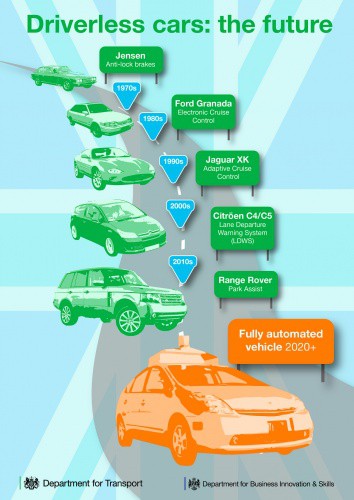Jez Coates, chief engineer – vehicle projects at Coventry-based RDM Group – made the comparison the iconic marque at the launch of the GATEway (Greenwich Automated Transport Environment) project in southeast London today.
GATEway is one of three projects chosen by the government to deliver demonstrations of automated vehicles in urban environments with RDM’s fully electric driverless pod spearheading the LUTZ (Low-carbon Urban Transport Zone) Pathfinder project in Milton Keynes, a project that will see pod vehicles operating along a predetermined footpath route.
The four-wheel steer LUTZ Pathfinder pod seats two people, can travel at a maximum speed of 15mph and has a range of 40 miles. To maintain a safe course of travel it uses sensor and navigation technology provided by Oxford University’s Mobile Robotics Group.
Coates said: ‘Its equipped…with an array of different types of sensors to build up a 3D picture of the environment it’s operating in. It holds that in its memory and every time it does a journey it augments the quality of the 3D model it has of the area it runs in.’
He added that a key challenge with the design was sizing the vehicle.
‘It’s tiny – its only 6’4” long,’ said Coates. ‘So actually sizing the vehicle so that its going to be capable of taking two people without feeling too cramped, but not be threatening on the pavement…[has] been a serious consideration.
‘Then you get in to the packaging of it. You’ve got to have room for people to dump a load of shopping when they get in it, room for [those] two people and it’s a high tech vehicle with four-wheel steer. Its electric, it’s got a six-hour battery pack and it’s a real challenge to get it in. It’s the true successor to Alec Issigonis’ Mini.
Another major concern with driverless systems is the cost of the sensors, which stand at £38,000 on the LUTZ Pathfinder Pod.
‘As the program develops the sensor arrays will change,’ said Coates. ‘We may end up with something on the roof – maybe front mounted and rear mounted – but that make maybe 10 of the other sensors redundant.’
RDM were orignially awarded a contract to construct three Pod vehicles for LUTZ Pathfinder trials that will take place on the pavements of Milton Keynes in the late spring of this year. The company is building a further 40 Pod vehicles for the £20m UK Autodrive project that will take place in Coventry as well as Milton Keynes.
In a statement transport minister Claire Perry said: ‘Driverless cars are the future. I want Britain to be at the forefront of this exciting new development, to embrace a technology that could transform our roads and open up a brand new route for global investment.
‘These are still early days but today is an important step. The trials present a fantastic opportunity for this country to take a lead internationally in the development of this new technology.’






Project REvAR aims for energy and clean water from sewage
I struggled to find much detail about <i>this</i> project but it seems to have similarities to another report from 2022...